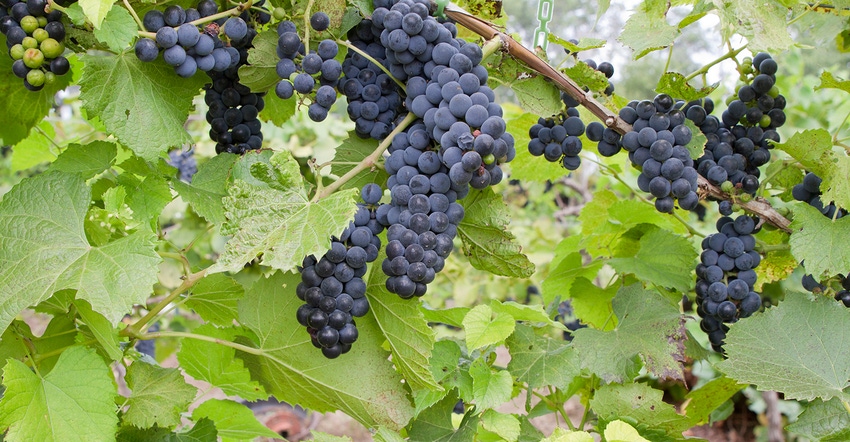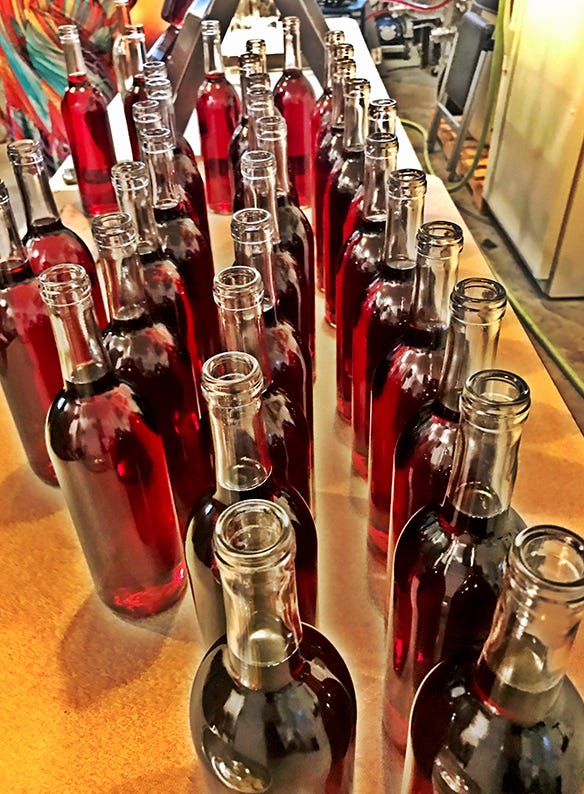May 12, 2017

By Kaci Levorsen
When you think of agriculture in the Red River Valley, grapes may not be the first thing that comes to mind. However, grape production is becoming more common thanks to the efforts of entrepreneurs, wine lovers and North Dakota State University and the University of Minnesota. The universities are developing cold-hardy varieties by crossing native varieties with high-quality wine varieties.
Red Trail Vineyard
Red Trail Vineyard, Buffalo, N.D., is one of the largest vineyards in the Valley. Rodney Hogen started with 120 vines in 2003, and over the years he has worked to expand his operation to more than 2,500 vines, which produce 12 different varieties of grapes.
“When I started the vineyard, it was a hobby,” he says. “I never thought things would get to where they are today.”
Expanding the operation was not easy. “As a small-grains farmer, a few acres of grapes seemed like such a small amount,” Hogen says. “I thought it would be simple, but I quickly learned that a lot of work goes into raising this commodity, especially in the North Dakota climate. It has been a continual learning process.”
It typically takes three years for a vine to mature to a point where it can begin to produce grapes. This entails working through several uncontrollable factors such as weather and birds. In addition, much of the work done in the vineyards is done by hand.
In 2004, Hogen came across a 100-year-old granary which he bought, moved out to the vineyard, and remodeled into what is now the tasting room. The tasting room provides a place for individuals to come out and sample some of the 10 wines made by North Dakota wineries using grapes that are grown and harvested from Red Trail Vineyard. These wines are available for sale by the glass or bottle.
In addition to wine tastings, the vineyard also hosts small gatherings, weddings and Friday night dinners throughout the summer months. There are currently 22 Friday dinners planned for 2017. All of the food for these events is made on-site by a chef and paired with wines made from grapes from Red Trail Vineyard.
For more information, see redtrailvineyards.com or facebook.com/RedTrailVineyards.

LOCAL FRUITS: Locally grown grapes and other fruits are used to produce wine at two wineries in the Red River Valley. (Photo: Kaci Levorsen)

4e Winery
Some of the grapes from Red Trail Vineyard go to 4e Winery, of Casselton. The winery gets its name from the ancient Greeks who believed everything was made up of four unchanging elements: earth, fire, water and air. Quality products, born of the northern prairie (earth), kissed by the sun (fire), nourished by the flowing rivers (water), and brought to life by prairie breezes (air) are the foundation of the wine made at 4e Winery.
The winery started in 2015 as hobby for Greg Cook, an NDSU chemistry professor, who wanted to craft quality wines from pure northern prairie ingredients. He operates the winery with his wife, Lisa. They currently produce a dozen different fruit wines. They add a few additional wines each year.
“Our goal is to produce the finest wines, allowing the purity of the fruit to express itself as it was meant to be with as little manipulation as possible,” Lisa says.
4e Winery is looking for more North Dakota-grown grapes. State law requires a North Dakota winery source more of its grapes from North Dakota each year it is business. In the second year of a North Dakota winery’s licensure, 10% of the fruit that goes into the wines must come from North Dakota. 4e Winery is currently in its third year of business, which means consumers can expect at least 20% of the fruit that goes into making the wine to be from North Dakota. After six years of existence, the requirement is capped, requiring that at least 51% of the fruit that goes in to the wine be sourced from North Dakota.
“It has been somewhat of a challenge and a limit to our growth to find a large amount of North Dakota fruit for our wines,” Lisa says. “As research continues to progress, we are hopeful that more fruit will be able to be grown in this region, and we will be able to further establish our small vineyard.”
In addition to crafting quality wines, 4e Winery strives to provide a winery experience. Visitors can come to the tasting room and learn the techniques to discover the flavors encapsulated in each of the wines. People may also plan a private event at the winery, enjoy some North Dakota wine, visit with good company, sit out on the porch and gaze at the North Dakota prairie as it stretches past 4e Winery’s vineyard.
“One of our favorite parts about the winery is how it gives us the opportunity to build relationships with our customers and meet people from all across the world,” Lisa says.
For more information, see 4ewinery.com or facebook.com/4eWinery.
Originally from Elgin, N.D., Levorsen is an intern at AgCountry Farm Credit Services and is currently studying marketing and agricultural economics at NDSU.
You May Also Like




